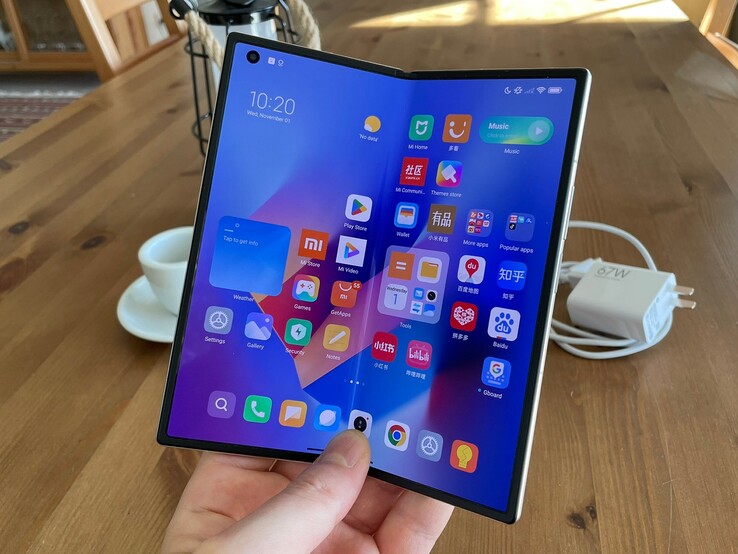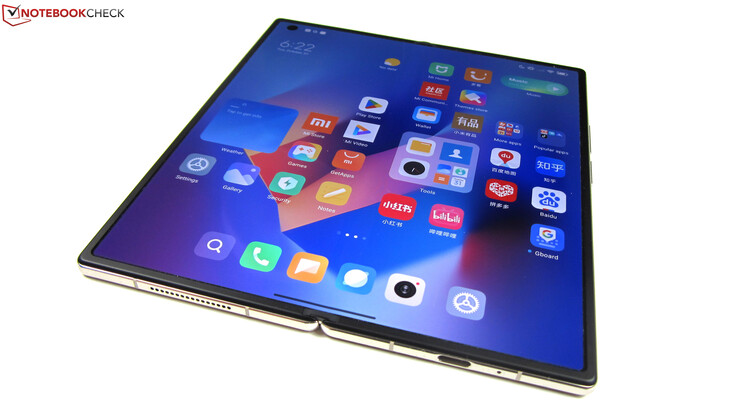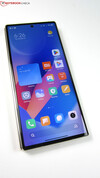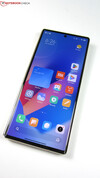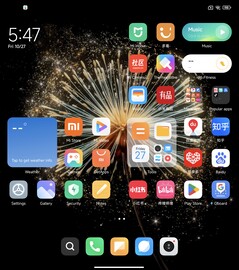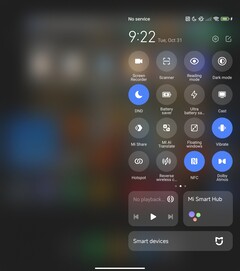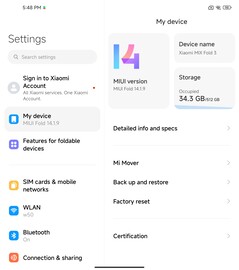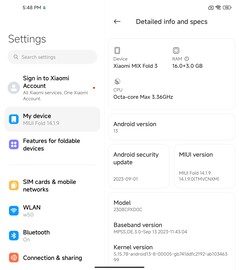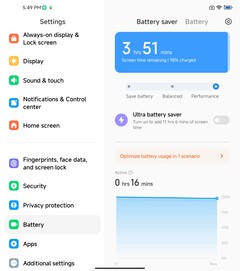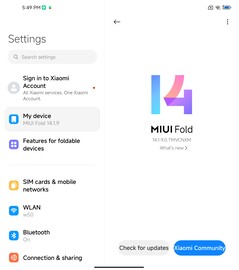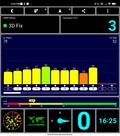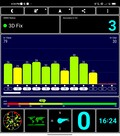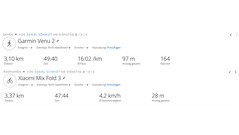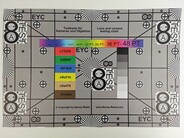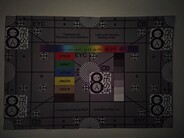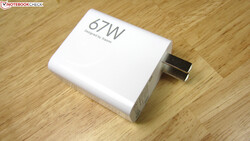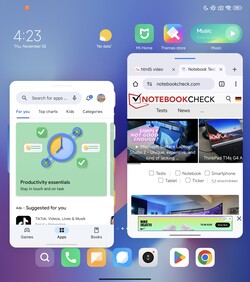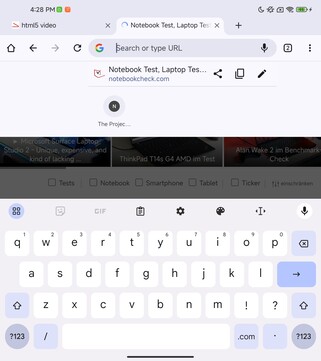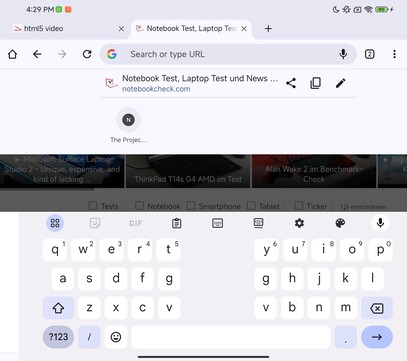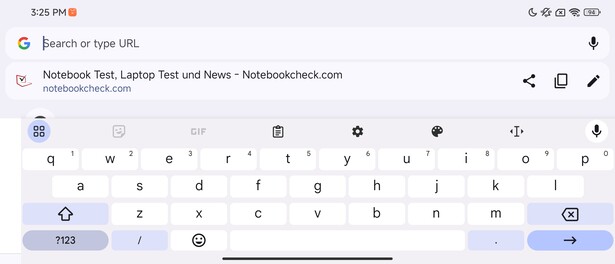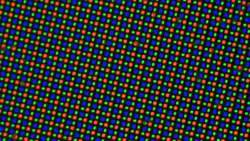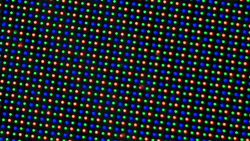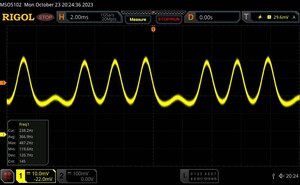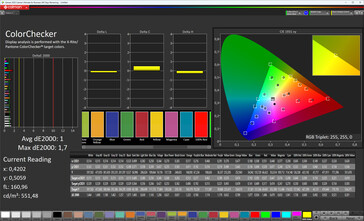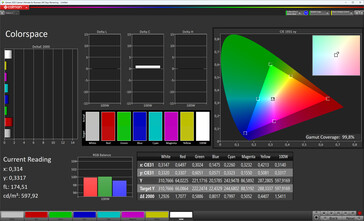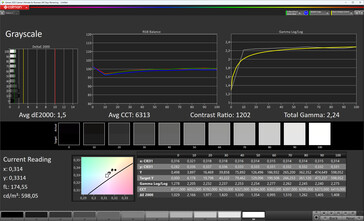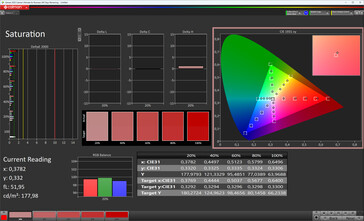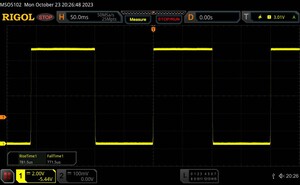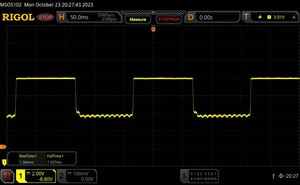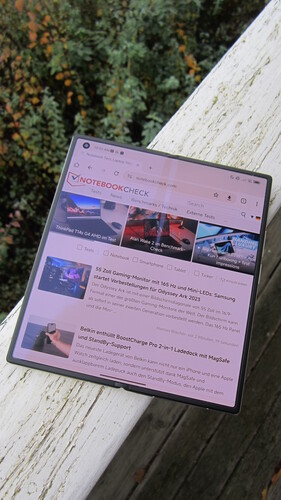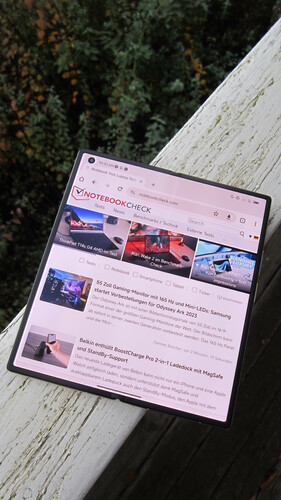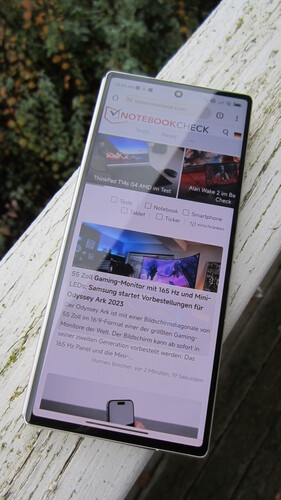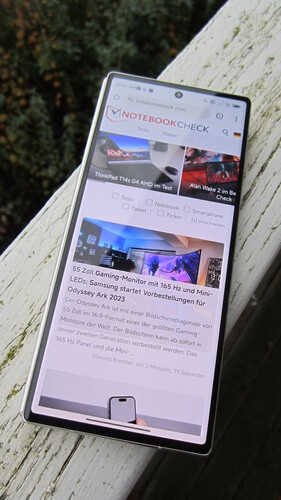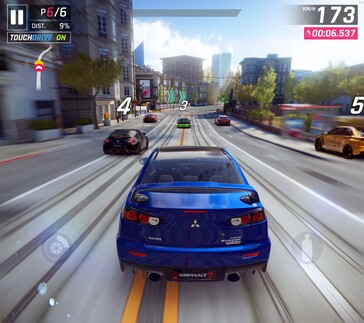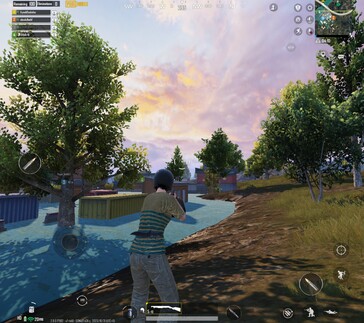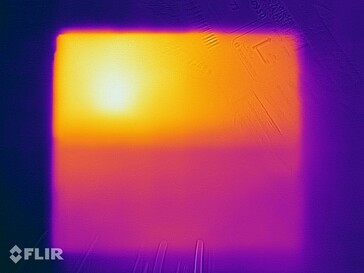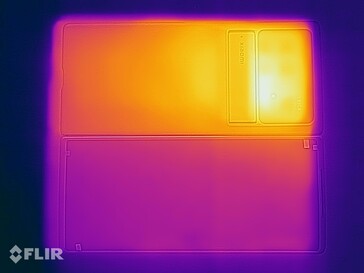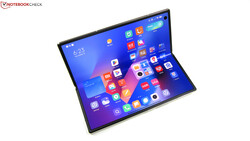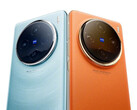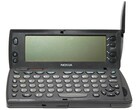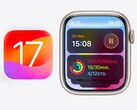Xiaomi Mix Fold 3 review: Foldable high-end smartphone with cosmetic flaw
Xiaomi is presenting a new foldable in the Mix Fold 3 that is a real flagship thanks to its powerful features, such as the Snapdragon 8 Gen 2, a total of 6 cameras and up to 1 TB of storage. Officially, the manufacturer only offers the Mix Fold 3 in China. On the other hand, it can also be purchased via importers.
Foldable top dogs such as the Google Pixel Fold and the Samsung Galaxy Z Fold5 will have to brace themselves, as the Mix Fold 3 stands out not only in terms of performance, but also starts at a very competitive price. In the smallest model with 256 GB memory, the Mix Fold 3 costs around US$1450 and is thus around the same price as the Galaxy Z Fold5. In contrast, the Google Pixel Fold was available for just under US$1800 at the time of review.
Possible competitors in comparison
Rating | Date | Model | Weight | Drive | Size | Resolution | Price |
|---|---|---|---|---|---|---|---|
| 87.3 % v7 (old) | 11 / 2023 | Xiaomi Mix Fold 3 SD 8 Gen 2, Adreno 740 | 259 g | 512 GB UFS 4.0 Flash | 8.03" | 2160x1916 | |
| 84.7 % v7 (old) | 08 / 2023 | Google Pixel Fold Tensor G2, Mali-G710 MP7 | 283 g | 256 GB UFS 3.1 Flash | 7.60" | 2208x1840 | |
| 87.2 % v7 (old) | 03 / 2023 | Honor Magic Vs SD 8+ Gen 1, Adreno 730 | 261 g | 512 GB UFS 3.1 Flash | 7.90" | 2272x1984 | |
| 86.3 % v7 (old) | 06 / 2023 | Huawei Mate X3 SD 8+ Gen 1, Adreno 730 | 239 g | 512 GB UFS 3.1 Flash | 7.85" | 2496x2224 | |
| 89.1 % v7 (old) | 08 / 2023 | Samsung Galaxy Z Fold5 SD 8 Gen 2 for Galaxy, Adreno 740 | 253 g | 256 GB UFS 4.0 Flash | 7.60" | 2176x1812 | |
| 86.3 % v7 (old) | 12 / 2022 | Xiaomi Mix Fold 2 SD 8+ Gen 1, Adreno 730 | 262 g | 256 GB UFS 3.1 Flash | 8.02" | 2160x1914 |
Case - Very slim foldable
The Xiaomi Mix Fold 3 is available in Black, Black Carbon and Gold, each with a different back cover design. The Gold and Black variants both have a matte glass back that is smoothly textured in gold, but feels similar to leather in the Black variant. In the third color variant, Black Carbon, the back is made from a mix of ceramic and aramid fibers, which has a carbon look and is said to be particularly durable. However, there is no IP certification for any color variant.
The Mix Fold 3 is surrounded by an aluminum frame, and the buttons and the solid hinge are made of the same material. The 6.56-inch AMOLED outer display is covered by Gorilla Glass Victus 2, while the 8.03-inch AMOLED interior display has a protective film applied to it. The fold crease is clearly visible and noticeable.
Like the rest of the housing, the aluminum frame is of high quality and confers good stability onto the foldable. When unfolded, there is very little play in the hinge area and strong applications of pressure are not enough to bend the Mix Fold 3 backwards. The hinge remains stable in the unfolded position without wobbling. According to Xiaomi, it is designed to last 500,000 folds. The elegant overall impression is only marred by the rather wide, matte plastic frame that surrounds the foldable panel.
When unfolded, the Xiaomi Mix Fold 3 measures 161.2 x 143.3 x 5.3 millimeters, making it one of the thinnest foldables currently available alongside the Huawei Mate X3. When folded, it measures a compact 161.2 x 73.5 x 11 millimeters and is therefore barely thicker than an Apple iPhone 15 Pro Max in a protective case. At 259 grams, it doesn't feel too heavy.
Equipment - Xiaomi Mix Fold 3 with USB 3.2 Gen.1 and IR blaster
Xiaomi offers the Mix Fold 3 in three configurations. The smallest variant is equipped with 12 GB of LPDDR5x RAM and 256 GB of UFS 4.0 storage and costs around US$1450. The middle variant offers 12 GB of RAM but 512 GB of storage space for around US$1700. In the largest version for around US$1800, the Mix Fold 3 offers 16 GB of RAM and 1 TB of storage. The storage cannot be expanded due to the lack of a microSD slot.
The Xiaomi foldable has an OTG-capable USB-C port that works according to the USB 3.1 Gen.1 standard, i.e. reaches USB 3.0 speeds. In the copy test with our external Samsung 980 Pro M2 SSD, the USB port reached a solid data throughput of 295.5 MB/s.
In addition to stereo speakers, a dual SIM slot and a fingerprint sensor integrated into the power button, other features also include an infrared transmitter that can be used, for example, to remotely control smart TVs.
Software - MIUI 14.1 with unclear update supply
The Mix Fold 3 uses MIUI 14.1, which is based on Android 13. On our Chinese import from TradingShenzhen the Google framework and the associated services are already running in the background, so that the Google Play Store can be easily installed if desired. This works, for example, via the preinstalled Xiaomi app store GetApps. The Mix Fold 3 also has DRM certification (Widevine L1), meaning that HD streaming is supported.
In addition to simplified Chinese, traditional Chinese, Tibetan and Ugurian, the only system language available on the the Mix Fold 3 is English. Many of the preinstalled apps are in Chinese, but can all be uninstalled if not needed. Freshly installed, Android 13 and MIUI 14.1 occupy around 34 GB on our 512 GB test device.
At the time of review in early November, the last Android security updates were from September 1 and thus no longer completely up to date. Xiaomi has not yet provided any information about how long the foldable will be provided with security updates and OS upgrades.
Communication and GNSS - WiFi 7 and frequency gaps
The Xiaomi Mix Fold 3 has solid frequency coverage for mobile communications. Compared to competitors such as the Samsung Galaxy Z Fold5, however, it is not all too extensive. Our test device lacks LTE band 20, which is important in Europe. Despite this limitation, there are unlikely to be reception issues in urban areas. However, the situation is likely to be completely different in rural areas.
At short distances, the Mix Fold 3 communicates via Bluetooth 5.3, NFC and WiFi 7 and is thus better positioned than its predecessor, the Mix Fold 2, which is limited to WiFi 6. Connected to our Asus ROG Rapture GT-AXE11000 reference router, it achieves WiFi transfer rates of over 1800 MBit/s on the 6 GHz band. Almost 1000 MBit/s is possible on the 5 GHz network.
| Networking | |
| Xiaomi Mix Fold 3 | |
| iperf3 receive AXE11000 | |
| iperf3 transmit AXE11000 | |
| iperf3 transmit AXE11000 6GHz | |
| iperf3 receive AXE11000 6GHz | |
| Google Pixel Fold | |
| iperf3 receive AXE11000 | |
| iperf3 transmit AXE11000 | |
| iperf3 transmit AXE11000 6GHz | |
| iperf3 receive AXE11000 6GHz | |
| Honor Magic Vs | |
| iperf3 receive AXE11000 | |
| iperf3 transmit AXE11000 | |
| Huawei Mate X3 | |
| iperf3 receive AXE11000 | |
| iperf3 transmit AXE11000 | |
| Samsung Galaxy Z Fold5 | |
| iperf3 receive AXE11000 | |
| iperf3 transmit AXE11000 | |
| iperf3 transmit AXE11000 6GHz | |
| iperf3 receive AXE11000 6GHz | |
| Xiaomi Mix Fold 2 | |
| iperf3 receive AXE11000 | |
| iperf3 transmit AXE11000 | |
| Average of class Smartphone | |
| iperf3 receive AXE11000 | |
| iperf3 transmit AXE11000 | |
| iperf3 transmit AXE11000 6GHz | |
| iperf3 receive AXE11000 6GHz | |
The Mix Fold 3 pinpoints its location via the GPS (L1, L5), Glonass (G1), Beidou (B1, B1c, B2a), Galileo (E1, E5a), QZSS (L1, L5) and NavIC (L5) satellite systems. Indoors, positioning takes a few seconds, but displays an accuracy of up to 3 meters. Outdoors, on the other hand, localization is almost instantaneous and just as precise.
We put the real-world tracking capabilities of Mix Fold 3 to the test by taking it along on a walk. However, it doesn't perform particularly well here. Compared to the Garmin Venu 2 fitness smartwatch, which didn't have the best day either, the foldable tracks the route much less accurately and occasionally produces large outliers.
Telephony and voice quality
The Xiaomi Mix Fold 3 offers space for 2 nano SIM cards. VoLTE and Wi-Fi calls are supported, but not eSIMs.
In our tests, the Mix Fold 3 delivers good voice quality. Calling partners can understand each other quite clearly, even in noisy environments, as background noise is filtered out quite effectively. However, when the loudspeaker is activated, a slight echo creeps in and the microphone range is not all that long.
Cameras - Quad camera with Sony IMX800
Despite the Leica branding, we weren't entirely convinced by the camera setup of the Mix Fold 2 predecessor, as the imaging performance of the additional lenses left a lot of room for improvement. For the successor, however, Xiaomi has really gone the extra mile and not only integrated more cameras, but also upgraded the quality. Starting with the selfie cameras.
Unlike the Mix Fold 2, there is now a selfie camera equipped with the Omnivision OV20B in the inner display, which increases the total number of cameras to 6. The same camera is also used on the outer display and takes good portrait photos, although they do not show a lot of contrast.
Instead of a triple camera, there is now a quad camera setup with two telephoto lenses on the back of the foldable, which was developed in cooperation with Leica. The main sensor is the Sony IMX800 (Mix Fold 2: IMX766) with 54 MP, of which 50 MP is effectively utilized. The same sensor is installed in the Xiaomi 13 and its Leica Vario-Summicron 1:18-2.9/ 15-115 ASPH nickname is immortalized on the back of the foldable.
Thanks to the collaboration with Leica, the two image modes Leica Vibrant (default) and Leica Authentic, which each work with slightly different color calibrations, are once again on board alongside numerous photo setting options. In daylight, the Mix Fold 3 with its 50 MP main sensor takes very good quality photos that impress with high image sharpness, natural colors and a strong dynamic range. Difficult lighting conditions pose no issue for the Mix Fold 3, as the sensor is able to capture lots of detail in low ambient light.
The 12 MP ultra-wide-angle camera (Omnivision OV13B10) only offers standard fare compared to the main camera and is actually much less than you would expect in this price range. The photos are solid, but still a little too pale overall.
Things get interesting again with the two telephoto cameras, both of which use the Samsung S5K3K1 as the image sensor. The 10 MP camera works with 3.2x optical magnification and is also used as the standard sensor for portrait shots. Its 12 MP colleague has 5x optical zoom. Digital magnification of up to 50x is possible. Both telephoto cameras take high-contrast and sharp photos and achieve very decent imaging performance overall. If you use the digital zoom, however, the quality of the images deteriorates rapidly and are visibly noisy.
The Mix Fold 3 records videos in 4K at up to 60 frames per second and in 8K at 24 FPS. Videos in the latter resolution can be recorded for a maximum of 6 minutes. If you activate HDR, videos can be recorded in a maximum of 4K at 30 FPS or alternatively at 24 FPS.
Image comparison
Choose a scene and navigate within the first image. One click changes the position on touchscreens. One click on the zoomed-in image opens the original in a new window. The first image shows the scaled photograph of the test device.
Daylight photo 1Daylight photo 2Ultra wide angle5x zoomLow lightUnder optimal lighting conditions in the lab, the Xiaomi Mix Fold 3 captures the Colorchecker color chart quite precisely and shows no abnormalities (Delta-E < 12). With the exception of the peripheral areas, the test chart is captured sharply and is still recognizable at 1 lux residual light, but also quite blurry.
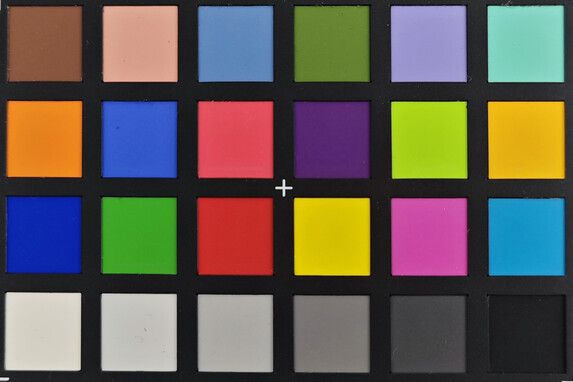

Accessories and warranty - Mix Fold 3 with extensive features
The Xiaomi Mix Fold 3 comes with a 67-watt power adapter (up to 20V/3.25A, plug type A), a USB cable (type A to C), a SIM tool, a protective case and a quick start guide. If you buy the smartphone from TradingShenzhen, you'll also receive a power adapter (plug type C) as a free gift.
The Xiaomi Mix Fold 3 comes with a 12-month warranty.
Input devices & operation: 120 Hz display and multitasking
The AMOLED displays on the Mix Fold 3 react very quickly and precisely to inputs. Thanks to their maximum refresh rate of 120 Hz, they display content very smoothly. We also have nothing but good things to say about the fingerprint sensor integrated into the power button, which we were always able to use to log in reliably and almost instantly in our tests. The much less secure 2D face scan of the selfie cameras can also be used for biometric authentication.
Switching between the two screens is very intuitive. Only one is active at a time. If you open the hinge ever so slightly, the 6.56-inch outer screen turns off and the 8.03-inch inner display turns on. Conversely, when the hinge is closed, only the outer screen is active. MIUI automatically adjusts the display of the screen content.
The large inner screen of the Mix Fold 3 is ideal for multitasking. This is exactly what the floating windows of MIUI 14.1 are designed for. With this feature, apps are displayed in separate windows that can be resized and moved around on the home screen as required. Not all apps support floating windows. But users quickly find out which ones do. All compatible apps can be called up directly via an expandable sidebar on the left edge of the screen. The floating windows are not available on the outer display.
Three keyboards come preinstalled on the Mix Fold 3: the Baidu IME, iFlytek IME and Sogou keyboards, which are optimized for Chinese users. For all other users, it is advisable to install an alternative keyboard such as the Google Gboard from the Google Play Store, because input otherwise takes a lot of getting used to.
Display - Up to 2300 nits in HDR mode
The foldable inner display of the Xiaomi Mix Fold 3 measures 8.03 inches and uses an AMOLED panel with a resolution of 2160 x 1916, corresponding to an unusual aspect ratio of 10.15:9 and a pixel density of 360 PPI.
Another special feature of the XXL display is its LTPO functionality. This allows for a lowering of the refresh rate from 120 Hz refresh rate down to 1 Hz. The 21:9 outer display of Xiaomi's foldable measures 6.56 inches, has a resolution of 2520 x 1080 and also works at a refresh rate of 120 Hz. However, unlike the inner display, it does not support LTPO.
In terms of brightness, both displays are not too different and both achieve four-digit luminance values when the brightness is adjusted manually. However, the inner display is a little brighter and reaches a peak value of 1308 cd/m² (outer display 1065 cd/m²) with evenly distributed light and dark areas (APL18) and the ambient light sensor activated.
When displaying HDR content, the brightness of the inner display even increases to up to 2301 cd/m² and is thus relatively close to the manufacturer's specification of 2600 nits. Conversely, we can only elicit a maximum of 603 cd/m² from the foldable when the brightness sensor is deactivated. At the lowest brightness setting we measured 2.59 cd/m².
The Mix Fold 3 uses pulse width modulation to control brightness and is therefore not spared from PWM flickering. Although both screens show a rather unsteady amplitude curve, the inner display flickers at a high 367 Hz on average, which shouldn't cause any complaints for sensitive users.
| |||||||||||||||||||||||||
Brightness Distribution: 96 %
Center on Battery: 1307 cd/m²
Contrast: ∞:1 (Black: 0 cd/m²)
ΔE ColorChecker Calman: 1 | ∀{0.5-29.43 Ø4.77}
ΔE Greyscale Calman: 1.5 | ∀{0.09-98 Ø5}
99.8% sRGB (Calman 2D)
Gamma: 2.24
CCT: 6313 K
| Xiaomi Mix Fold 3 AMOLED, 2160x1916, 8" | Xiaomi Mix Fold 3 AMOLED, 2520x1080, 6.6" | Google Pixel Fold OLED, 2208x1840, 7.6" | Honor Magic Vs OLED, 2272x1984, 7.9" | Huawei Mate X3 OLED, 2496x2224, 7.9" | Samsung Galaxy Z Fold5 Dynamic AMOLED, 2176x1812, 7.6" | Xiaomi Mix Fold 2 OLED, 2160x1914, 8" | |
|---|---|---|---|---|---|---|---|
| Screen | -7% | -36% | -103% | -27% | -81% | -46% | |
| Brightness middle (cd/m²) | 1307 | 1020 -22% | 993 -24% | 803 -39% | 948 -27% | 1104 -16% | 1015 -22% |
| Brightness (cd/m²) | 1308 | 1065 -19% | 997 -24% | 809 -38% | 969 -26% | 1107 -15% | 1022 -22% |
| Brightness Distribution (%) | 96 | 84 -12% | 94 -2% | 97 1% | 94 -2% | 97 1% | 98 2% |
| Black Level * (cd/m²) | |||||||
| Colorchecker dE 2000 * | 1 | 0.9 10% | 1.4 -40% | 2.27 -127% | 1.4 -40% | 3.1 -210% | 1.6 -60% |
| Colorchecker dE 2000 max. * | 1.7 | 2 -18% | 3.2 -88% | 5.99 -252% | 2.6 -53% | 4.2 -147% | 3.4 -100% |
| Greyscale dE 2000 * | 1.5 | 1.2 20% | 2.1 -40% | 3.9 -160% | 1.7 -13% | 3 -100% | 2.6 -73% |
| Gamma | 2.24 98% | 2.26 97% | 2.24 98% | 2.25 98% | 2.15 102% | 2.01 109% | 2.22 99% |
| CCT | 6313 103% | 6436 101% | 6796 96% | 6234 104% | 6539 99% | 6594 99% | 6506 100% |
* ... smaller is better
Screen Flickering / PWM (Pulse-Width Modulation)
| Screen flickering / PWM detected | 367 Hz | ||
The display backlight flickers at 367 Hz (worst case, e.g., utilizing PWM) . The frequency of 367 Hz is relatively high, so most users sensitive to PWM should not notice any flickering. However, there are reports that some users are still sensitive to PWM at 500 Hz and above, so be aware. In comparison: 53 % of all tested devices do not use PWM to dim the display. If PWM was detected, an average of 8084 (minimum: 5 - maximum: 343500) Hz was measured. | |||
Series of measurements at a fixed zoom level and different brightness settings (foldable display)
Series of measurements at a fixed zoom level and different brightness settings (outer display)
Color representation is very accurate if you select the Original Color Pro color profile, which uses the sRGB color space. In the default Vivid setting, the display is slightly cooler, but uses the significantly larger DCI-P3 color space.
Display Response Times
| ↔ Response Time Black to White | ||
|---|---|---|
| 1.55 ms ... rise ↗ and fall ↘ combined | ↗ 0.7815 ms rise | |
| ↘ 0.7715 ms fall | ||
| The screen shows very fast response rates in our tests and should be very well suited for fast-paced gaming. In comparison, all tested devices range from 0.1 (minimum) to 240 (maximum) ms. » 8 % of all devices are better. This means that the measured response time is better than the average of all tested devices (20.2 ms). | ||
| ↔ Response Time 50% Grey to 80% Grey | ||
| 3.32 ms ... rise ↗ and fall ↘ combined | ↗ 1.384 ms rise | |
| ↘ 1.937 ms fall | ||
| The screen shows very fast response rates in our tests and should be very well suited for fast-paced gaming. In comparison, all tested devices range from 0.165 (minimum) to 636 (maximum) ms. » 13 % of all devices are better. This means that the measured response time is better than the average of all tested devices (31.6 ms). | ||
The Xiaomi Mix Fold 3 cuts a very fine figure outdoors thanks to its bright display. Even on very sunny days, screen content on the viewing angle-stable screen can be easily seen.
Performance - High-end performance with the Snapdragon 8 Gen 2
Using the Snapdragon 8 Gen 2, the Xiaomi Mix Fold 3 has one of the most powerful processors currently available for mobile devices. The high-end SoC has at least 12 GB of LPDDR5x RAM at its disposal. This means that the Mix Fold 3 not only impresses in the benchmarks, but also performs extremely well in all kinds of scenarios in everyday life.
| UL Procyon AI Inference for Android - Overall Score NNAPI | |
| Xiaomi Mix Fold 2 | |
| Google Pixel Fold | |
| Average of class Smartphone (3769 - 81594, n=132, last 2 years) | |
| Xiaomi Mix Fold 3 | |
| Average Qualcomm Snapdragon 8 Gen 2 (11338 - 16880, n=21) | |
| Honor Magic Vs | |
| Samsung Galaxy Z Fold5 | |
In the Mix Fold 3, the Adreno 740 handles graphics processing and ensures the foldable a top spot in the GPU benchmarks. Our test candidate and the Samsung Galaxy Z Fold5 are evenly matched for the most part, whereas the Honor Magic Vs, the Huawei Mate X3 and the Xiaomi Mix Fold 2 follow at a somewhat respectful distance. The Google Pixel Fold is no match for the strong competition and usually falls well behind.
GFXBench (DX / GLBenchmark) 2.7: T-Rex Onscreen | 1920x1080 T-Rex Offscreen
GFXBench 3.0: on screen Manhattan Onscreen OGL | 1920x1080 1080p Manhattan Offscreen
GFXBench 3.1: on screen Manhattan ES 3.1 Onscreen | 1920x1080 Manhattan ES 3.1 Offscreen
GFXBench: on screen Car Chase Onscreen | 1920x1080 Car Chase Offscreen | on screen Aztec Ruins High Tier Onscreen | 2560x1440 Aztec Ruins High Tier Offscreen | on screen Aztec Ruins Normal Tier Onscreen | 1920x1080 Aztec Ruins Normal Tier Offscreen | 3840x2160 4K Aztec Ruins High Tier Offscreen
| 3DMark / Wild Life Extreme Unlimited | |
| Samsung Galaxy Z Fold5 | |
| Xiaomi Mix Fold 3 | |
| Huawei Mate X3 | |
| Honor Magic Vs | |
| Xiaomi Mix Fold 2 | |
| Google Pixel Fold | |
| 3DMark / Wild Life Extreme | |
| Xiaomi Mix Fold 3 | |
| Samsung Galaxy Z Fold5 | |
| Huawei Mate X3 | |
| Honor Magic Vs | |
| Xiaomi Mix Fold 2 | |
| Google Pixel Fold | |
| 3DMark / Wild Life Unlimited Score | |
| Xiaomi Mix Fold 3 | |
| Samsung Galaxy Z Fold5 | |
| Huawei Mate X3 | |
| Xiaomi Mix Fold 2 | |
| Honor Magic Vs | |
| Google Pixel Fold | |
| 3DMark / Sling Shot Extreme (ES 3.1) Unlimited Physics | |
| Xiaomi Mix Fold 3 | |
| Huawei Mate X3 | |
| Samsung Galaxy Z Fold5 | |
| Xiaomi Mix Fold 2 | |
| Google Pixel Fold | |
| 3DMark / Sling Shot Extreme (ES 3.1) Unlimited Graphics | |
| Xiaomi Mix Fold 3 | |
| Samsung Galaxy Z Fold5 | |
| Huawei Mate X3 | |
| Xiaomi Mix Fold 2 | |
| Google Pixel Fold | |
| 3DMark / Sling Shot Extreme (ES 3.1) Unlimited | |
| Xiaomi Mix Fold 3 | |
| Samsung Galaxy Z Fold5 | |
| Huawei Mate X3 | |
| Xiaomi Mix Fold 2 | |
| Google Pixel Fold | |
| GFXBench (DX / GLBenchmark) 2.7 / T-Rex Onscreen | |
| Google Pixel Fold | |
| Samsung Galaxy Z Fold5 | |
| Xiaomi Mix Fold 3 | |
| Xiaomi Mix Fold 2 | |
| Huawei Mate X3 | |
| Honor Magic Vs | |
| GFXBench (DX / GLBenchmark) 2.7 / T-Rex Offscreen | |
| Xiaomi Mix Fold 3 | |
| Huawei Mate X3 | |
| Honor Magic Vs | |
| Xiaomi Mix Fold 2 | |
| Samsung Galaxy Z Fold5 | |
| Google Pixel Fold | |
| GFXBench 3.0 / Manhattan Onscreen OGL | |
| Xiaomi Mix Fold 3 | |
| Xiaomi Mix Fold 2 | |
| Samsung Galaxy Z Fold5 | |
| Huawei Mate X3 | |
| Google Pixel Fold | |
| Honor Magic Vs | |
| GFXBench 3.0 / 1080p Manhattan Offscreen | |
| Xiaomi Mix Fold 3 | |
| Honor Magic Vs | |
| Huawei Mate X3 | |
| Xiaomi Mix Fold 2 | |
| Samsung Galaxy Z Fold5 | |
| Google Pixel Fold | |
| GFXBench 3.1 / Manhattan ES 3.1 Onscreen | |
| Xiaomi Mix Fold 3 | |
| Xiaomi Mix Fold 2 | |
| Samsung Galaxy Z Fold5 | |
| Huawei Mate X3 | |
| Honor Magic Vs | |
| Google Pixel Fold | |
| GFXBench 3.1 / Manhattan ES 3.1 Offscreen | |
| Xiaomi Mix Fold 3 | |
| Honor Magic Vs | |
| Xiaomi Mix Fold 2 | |
| Huawei Mate X3 | |
| Samsung Galaxy Z Fold5 | |
| Google Pixel Fold | |
| GFXBench / Car Chase Onscreen | |
| Xiaomi Mix Fold 3 | |
| Honor Magic Vs | |
| Samsung Galaxy Z Fold5 | |
| Xiaomi Mix Fold 2 | |
| Huawei Mate X3 | |
| Google Pixel Fold | |
| GFXBench / Car Chase Offscreen | |
| Xiaomi Mix Fold 3 | |
| Huawei Mate X3 | |
| Honor Magic Vs | |
| Xiaomi Mix Fold 2 | |
| Samsung Galaxy Z Fold5 | |
| Google Pixel Fold | |
| GFXBench / Aztec Ruins High Tier Onscreen | |
| Samsung Galaxy Z Fold5 | |
| Xiaomi Mix Fold 3 | |
| Honor Magic Vs | |
| Xiaomi Mix Fold 2 | |
| Huawei Mate X3 | |
| Google Pixel Fold | |
| GFXBench / Aztec Ruins High Tier Offscreen | |
| Xiaomi Mix Fold 3 | |
| Samsung Galaxy Z Fold5 | |
| Huawei Mate X3 | |
| Honor Magic Vs | |
| Xiaomi Mix Fold 2 | |
| Google Pixel Fold | |
| GFXBench / Aztec Ruins Normal Tier Onscreen | |
| Xiaomi Mix Fold 3 | |
| Samsung Galaxy Z Fold5 | |
| Honor Magic Vs | |
| Xiaomi Mix Fold 2 | |
| Huawei Mate X3 | |
| Google Pixel Fold | |
| GFXBench / Aztec Ruins Normal Tier Offscreen | |
| Xiaomi Mix Fold 3 | |
| Huawei Mate X3 | |
| Samsung Galaxy Z Fold5 | |
| Honor Magic Vs | |
| Xiaomi Mix Fold 2 | |
| Google Pixel Fold | |
| GFXBench / 4K Aztec Ruins High Tier Offscreen | |
| Samsung Galaxy Z Fold5 | |
| Xiaomi Mix Fold 3 | |
| Huawei Mate X3 | |
| Honor Magic Vs | |
| Xiaomi Mix Fold 2 | |
| Google Pixel Fold | |
As in the synthetic benchmarks and in the GPU tests, the Xiaomi Mix Fold 3 also proves in the browser benchmarks that it is one of the fastest foldables you can currently get. For the tests, we used Google Chrome instead of the preinstalled Silk Browser.
| Jetstream 2 - 2.0 Total Score | |
| Samsung Galaxy Z Fold5 (Chrome 115) | |
| Xiaomi Mix Fold 3 (Chrome 118.0.05993.111) | |
| Average of class Smartphone (23.8 - 387, n=147, last 2 years) | |
| Average Qualcomm Snapdragon 8 Gen 2 (62.7 - 179.2, n=23) | |
| Honor Magic Vs (Chrome 111) | |
| Google Pixel Fold (Chrome 115) | |
| Huawei Mate X3 (Huawei Browser 13.0.4) | |
| Xiaomi Mix Fold 2 (MiUI-Browser 14.7) | |
| Speedometer 2.0 - Result 2.0 | |
| Average of class Smartphone (15.2 - 643, n=119, last 2 years) | |
| Xiaomi Mix Fold 3 (Chrome 118.0.05993.111) | |
| Average Qualcomm Snapdragon 8 Gen 2 (62.9 - 225, n=18) | |
| Google Pixel Fold (Chrome 115) | |
| Honor Magic Vs (Chome 111) | |
| WebXPRT 4 - Overall | |
| Samsung Galaxy Z Fold5 (Chrome 115) | |
| Xiaomi Mix Fold 3 (Chrome 118.0.05993.111) | |
| Average of class Smartphone (27 - 306, n=143, last 2 years) | |
| Average Qualcomm Snapdragon 8 Gen 2 (28 - 183, n=22) | |
| Google Pixel Fold (Chrome 115) | |
| Huawei Mate X3 (Huawei Browser 13.0.4) | |
| Honor Magic Vs (Chrome 111) | |
| Xiaomi Mix Fold 2 | |
| WebXPRT 3 - Overall | |
| Xiaomi Mix Fold 3 (Chrome 118.0.05993.111) | |
| Average Qualcomm Snapdragon 8 Gen 2 (115 - 238, n=11) | |
| Average of class Smartphone (38 - 380, n=30, last 2 years) | |
| Honor Magic Vs (Chrome 111) | |
| Octane V2 - Total Score | |
| Xiaomi Mix Fold 3 (Chrome 118.0.05993.111) | |
| Samsung Galaxy Z Fold5 (Chrome 115) | |
| Huawei Mate X3 (Huawei Browser 13.0.4) | |
| Average of class Smartphone (2228 - 126661, n=194, last 2 years) | |
| Average Qualcomm Snapdragon 8 Gen 2 (19870 - 65418, n=25) | |
| Google Pixel Fold (Chrome 115) | |
| Honor Magic Vs (Chrome 111) | |
| Xiaomi Mix Fold 2 (MiUI-Browser 14.7) | |
| Mozilla Kraken 1.1 - Total | |
| Xiaomi Mix Fold 2 (MiUI-Browser 14.7) | |
| Average of class Smartphone (257 - 28190, n=154, last 2 years) | |
| Google Pixel Fold (Chrome 115) | |
| Honor Magic Vs (Chrome 111) | |
| Average Qualcomm Snapdragon 8 Gen 2 (602 - 1837, n=22) | |
| Huawei Mate X3 (Huawei Browser 13.0.4) | |
| Samsung Galaxy Z Fold5 (Chrome 115) | |
| Xiaomi Mix Fold 3 (Chrome 118.0.05993.111) | |
* ... smaller is better
With its UFS 4.0 storage, the Mix Fold 3 achieves a very high data throughput. Large apps have extremely short loading times. Apps are installed practically instantaneously.
| Xiaomi Mix Fold 3 | Google Pixel Fold | Honor Magic Vs | Huawei Mate X3 | Samsung Galaxy Z Fold5 | Xiaomi Mix Fold 2 | Average 512 GB UFS 4.0 Flash | Average of class Smartphone | |
|---|---|---|---|---|---|---|---|---|
| AndroBench 3-5 | -53% | -45% | -34% | -11% | -27% | 1% | -32% | |
| Sequential Read 256KB (MB/s) | 3572.73 | 1606.37 -55% | 1695.2 -53% | 1953.41 -45% | 4384.43 23% | 1882.11 -47% | 3689 ? 3% | 2235 ? -37% |
| Sequential Write 256KB (MB/s) | 2897.27 | 1169.32 -60% | 1296.5 -55% | 1479.42 -49% | 2449.23 -15% | 1783.27 -38% | 3092 ? 7% | 1871 ? -35% |
| Random Read 4KB (MB/s) | 389.81 | 219.11 -44% | 270.2 -31% | 261.78 -33% | 459.94 18% | 342.67 -12% | 385 ? -1% | 297 ? -24% |
| Random Write 4KB (MB/s) | 506.41 | 238.72 -53% | 300.1 -41% | 466.74 -8% | 161.39 -68% | 446.48 -12% | 474 ? -6% | 343 ? -32% |
Gaming - Always enough FPS at the ready
The Snapdragon 8 Gen 2, 12 or 16 GB of RAM and the Adreno 740 GPU make the Mix Fold 3 a very powerful gaming platform. Our PUBG Mobile and Asphalt 9 test games run smoothly at all times, even at maximum detail levels. Unfortunately, we are unable to provide specific frame rates because the foldable refused to provide our Gamebench test tool with the corresponding values.
Emissions - The Mix Fold 3 can overheat
Temperature
The surface temperatures of the Mix Fold 3 are very low when idle at a maximum of 26 °C. Under load, however, they increase considerably and peak at 49.4 °C. The greatest heating occurs on the right side of the foldable and is concentrated in the area of the rear camera module.
Under heavy load, it can happen that apps or benchmark tests are disrupted by overheating warnings. This also initially occurred in the 3DMark Wild Life stress test, where the Xiaomi gets too hot. After a longer cooling phase, however, both stress test scenarios run through to the end. The Xiaomi sometimes loses almost 30% of its performance, but still performs comparatively well.
(-) The maximum temperature on the upper side is 49.4 °C / 121 F, compared to the average of 35.2 °C / 95 F, ranging from 21.9 to 247 °C for the class Smartphone.
(±) The bottom heats up to a maximum of 42.9 °C / 109 F, compared to the average of 34 °C / 93 F
(+) In idle usage, the average temperature for the upper side is 25.5 °C / 78 F, compared to the device average of 32.9 °C / 91 F.
3DMark Wild Life Stress Test
| 3DMark | |
| Wild Life Stress Test Stability | |
| Xiaomi Mix Fold 3 | |
| Honor Magic Vs | |
| Samsung Galaxy Z Fold5 | |
| Google Pixel Fold | |
| Huawei Mate X3 | |
| Wild Life Extreme Stress Test | |
| Xiaomi Mix Fold 2 | |
| Xiaomi Mix Fold 3 | |
| Honor Magic Vs | |
| Samsung Galaxy Z Fold5 | |
| Google Pixel Fold | |
| Huawei Mate X3 | |
Speakers
Xiaomi installs stereo speakers from Harman Kardon in the Mix Fold 3, which support Dolby Atmos. Since both are located above and below the outer display, the sound has some "punch" from the left when you unfold the foldable. The speakers aren't bad by smartphone standards, but we are still unimpressed as they produce rather thin and treble-heavy sound.
Audio devices can be connected to the foldable via Bluetooth 5.3 and USB-C. The Mix Fold 3 supports practically all important Bluetooth codecs, including AAC, SBC, LDAC, aptX, aptX HD, aptX Adaptive and LHDC V1 to V5.
Xiaomi Mix Fold 3 audio analysis
(+) | speakers can play relatively loud (87 dB)
Bass 100 - 315 Hz
(-) | nearly no bass - on average 26.8% lower than median
(±) | linearity of bass is average (9.2% delta to prev. frequency)
Mids 400 - 2000 Hz
(+) | balanced mids - only 3.8% away from median
(+) | mids are linear (5.8% delta to prev. frequency)
Highs 2 - 16 kHz
(+) | balanced highs - only 2.1% away from median
(+) | highs are linear (1.5% delta to prev. frequency)
Overall 100 - 16.000 Hz
(±) | linearity of overall sound is average (15.5% difference to median)
Compared to same class
» 4% of all tested devices in this class were better, 3% similar, 93% worse
» The best had a delta of 11%, average was 35%, worst was 134%
Compared to all devices tested
» 22% of all tested devices were better, 4% similar, 74% worse
» The best had a delta of 4%, average was 24%, worst was 134%
Samsung Galaxy Z Fold5 audio analysis
(+) | speakers can play relatively loud (88.4 dB)
Bass 100 - 315 Hz
(-) | nearly no bass - on average 20.2% lower than median
(±) | linearity of bass is average (11.5% delta to prev. frequency)
Mids 400 - 2000 Hz
(±) | higher mids - on average 6.2% higher than median
(+) | mids are linear (5.4% delta to prev. frequency)
Highs 2 - 16 kHz
(±) | higher highs - on average 6.5% higher than median
(+) | highs are linear (4.2% delta to prev. frequency)
Overall 100 - 16.000 Hz
(±) | linearity of overall sound is average (18.3% difference to median)
Compared to same class
» 18% of all tested devices in this class were better, 9% similar, 73% worse
» The best had a delta of 11%, average was 35%, worst was 134%
Compared to all devices tested
» 39% of all tested devices were better, 8% similar, 53% worse
» The best had a delta of 4%, average was 24%, worst was 134%
Battery life - Fast charging with 67 watts and wireless charging
Power consumption
The 4800 mAh battery is quickly recharged with the included 67-watt power supply. In testing, it only took 44 minutes for a completely empty battery to reach 100%. The Mix Fold 3 supports wireless charging with up to 50 watts.
In terms of power consumption, the Xiaomi presents a very mixed picture. When idle, it is very frugal with an average of 1.05 watts. Under load, on the other hand, it consumes an impressive 15.3 watts on average, which is significantly more than all comparison devices.
| Off / Standby | |
| Idle | |
| Load |
|
Key:
min: | |
| Xiaomi Mix Fold 3 4800 mAh | Google Pixel Fold 4821 mAh | Honor Magic Vs 5000 mAh | Huawei Mate X3 4800 mAh | Samsung Galaxy Z Fold5 4400 mAh | Xiaomi Mix Fold 2 4500 mAh | Average Qualcomm Snapdragon 8 Gen 2 | Average of class Smartphone | |
|---|---|---|---|---|---|---|---|---|
| Power Consumption | -10% | -21% | -109% | 27% | 11% | -15% | 0% | |
| Idle Minimum * (Watt) | 0.86 | 0.86 -0% | 1.3 -51% | 0.81 6% | 0.55 36% | 0.97 -13% | 1.036 ? -20% | 0.847 ? 2% |
| Idle Average * (Watt) | 1.05 | 1.7 -62% | 1.7 -62% | 4.26 -306% | 0.9 14% | 1.37 -30% | 1.766 ? -68% | 1.448 ? -38% |
| Idle Maximum * (Watt) | 1.07 | 1.8 -68% | 2 -87% | 4.45 -316% | 1 7% | 1.48 -38% | 1.94 ? -81% | 1.633 ? -53% |
| Load Average * (Watt) | 15.27 | 9.1 40% | 7 54% | 10.11 34% | 9.58 37% | 3.98 74% | 7.22 ? 53% | 6.96 ? 54% |
| Load Maximum * (Watt) | 17.78 | 11.06 38% | 10.1 43% | 11.58 35% | 10.74 40% | 6.83 62% | 10.4 ? 42% | 11.3 ? 36% |
* ... smaller is better
Power consumption: Geekbench (150 cd/m²)
Power consumption: GFXBench (150 cd/m²)
Battery life
Although the battery of the Mix Fold 3 has only grown by 300 mAh compared to its predecessor, the battery life has increased significantly. In the WiFi test, which we carried out with the screen brightness set to 150 cd/m², the Xiaomi lasted almost 6 hours longer than the Mix Fold 2 at 15:23 hours. The Mix Fold 3 also performs very well during video playback in a continuous loop under the same test conditions, achieving almost 23 hours. This makes it one of the most enduring high-end foldables at present.
| Xiaomi Mix Fold 3 4800 mAh | Google Pixel Fold 4821 mAh | Honor Magic Vs 5000 mAh | Huawei Mate X3 4800 mAh | Samsung Galaxy Z Fold5 4400 mAh | Xiaomi Mix Fold 2 4500 mAh | |
|---|---|---|---|---|---|---|
| Battery runtime | -22% | -18% | -49% | -18% | -38% | |
| Reader / Idle (h) | 35.5 | 26.4 -26% | 23.9 -33% | |||
| H.264 (h) | 22.9 | 16 -30% | 18.2 -21% | |||
| WiFi v1.3 (h) | 15.4 | 10.9 -29% | 12.6 -18% | 7.9 -49% | 12.7 -18% | 9.5 -38% |
| Load (h) | 4.5 | 4.3 -4% | 4.5 0% |
Pros
Cons
Verdict on the Xiaomi Mix Fold 3
The Xiaomi Mix Fold 3 is a high-end foldable that is cheaper than many of its competitors with comparable features and performance. Compared to its predecessor, the Mix Fold 2, our test candidate has improved in many areas and scores particularly well with its slim design. Thanks to the Snapdragon 8 Gen 2 and at least 12 GB of RAM, its everyday performance values leave nothing to be desired. However, the foldable can overheat if pushed too hard over long periods of time.
The Xiaomi Mix Fold 3 is a very powerful foldable at an attractive price. However, there is a large gap in the features offered.
In addition to flagship-worthy features such as WiFi 7 and two 120 Hz fast AMOLED displays with four-digit peak brightness, the Mix Fold 3 also attracts attention with its extensive camera equipment. The 50 MP main camera equipped with the Sony IMX800 and the two 10 and 12 MP telephoto lenses not only deliver very good image quality, but also allow smartphone photographers plenty of creative freedom to design their shots.
Xiaomi officially offers the Mix Fold 3 only in China. On the other hand, interested buyers may be able to purchase the foldable via importers such as TradingShenzhen, but will then have to make do with a system interface in English. However, this lacks LTE band 20, which is important in countries such as Germany and plays no role in Asia. Anyone who often travels in rural areas with their mobile device may experience reception problems.
Alternatives to the Xiaomi Mix Fold 3 include the Xiaomi Mix Fold 2 or the Samsung Galaxy Z Fold5, which is now at a price level similar to the test candidate.
Price and availability
The Xiaomi Mix Fold 3 is available in all storage variants at TradingShenzhen, with the smallest configuration (12GB/256GB) starting at around US$1370.
Prices are as of 07.11.2023 and are subject to change.
Xiaomi Mix Fold 3
- 05/23/2024 v7 (old)
Manuel Masiero
Transparency
The selection of devices to be reviewed is made by our editorial team. The test sample was provided to the author as a loan by the manufacturer or retailer for the purpose of this review. The lender had no influence on this review, nor did the manufacturer receive a copy of this review before publication. There was no obligation to publish this review. As an independent media company, Notebookcheck is not subjected to the authority of manufacturers, retailers or publishers.
This is how Notebookcheck is testing
Every year, Notebookcheck independently reviews hundreds of laptops and smartphones using standardized procedures to ensure that all results are comparable. We have continuously developed our test methods for around 20 years and set industry standards in the process. In our test labs, high-quality measuring equipment is utilized by experienced technicians and editors. These tests involve a multi-stage validation process. Our complex rating system is based on hundreds of well-founded measurements and benchmarks, which maintains objectivity. Further information on our test methods can be found here.




